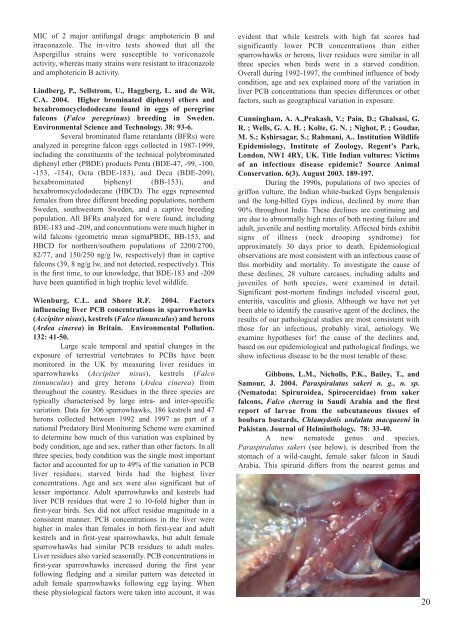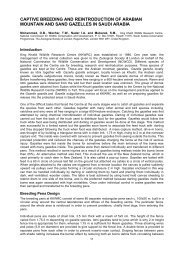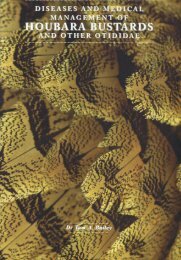His Highness Sheikh Zayed bin Sultan Al Nahyan - Wildlife Middle ...
His Highness Sheikh Zayed bin Sultan Al Nahyan - Wildlife Middle ...
His Highness Sheikh Zayed bin Sultan Al Nahyan - Wildlife Middle ...
Create successful ePaper yourself
Turn your PDF publications into a flip-book with our unique Google optimized e-Paper software.
MIC of 2 major antifungal drugs: amphotericin B and<br />
itraconazole. The in-vitro tests showed that all the<br />
Aspergillus strains were susceptible to voriconazole<br />
activity, whereas many strains were resistant to itraconazole<br />
and amphotericin B activity.<br />
Lindberg, P., Sellstrom, U., Haggberg, L. and de Wit,<br />
C.A. 2004. Higher brominated diphenyl ethers and<br />
hexabromocyclododecane found in eggs of peregrine<br />
falcons (Falco peregrinus) breeding in Sweden.<br />
Environmental Science and Technology. 38: 93-6.<br />
Several brominated flame retardants (BFRs) were<br />
analyzed in peregrine falcon eggs collected in 1987-1999,<br />
including the constituents of the technical polybrominated<br />
diphenyl ether (PBDE) products Penta (BDE-47, -99, -100,<br />
-153, -154), Octa (BDE-183), and Deca (BDE-209),<br />
hexabrominated biphenyl (BB-153), and<br />
hexabromocyclododecane (HBCD). The eggs represented<br />
females from three different breeding populations, northern<br />
Sweden, southwestern Sweden, and a captive breeding<br />
population. <strong>Al</strong>l BFRs analyzed for were found, including<br />
BDE-183 and -209, and concentrations were much higher in<br />
wild falcons (geometric mean sigmaPBDE, BB-153, and<br />
HBCD for northern/southern populations of 2200/2700,<br />
82/77, and 150/250 ng/g lw, respectively) than in captive<br />
falcons (39, 8 ng/g lw, and not detected, respectively). This<br />
is the first time, to our knowledge, that BDE-183 and -209<br />
have been quantified in high trophic level wildlife.<br />
Wienburg, C.L. and Shore R.F. 2004. Factors<br />
influencing liver PCB concentrations in sparrowhawks<br />
(Accipiter nisus), kestrels (Falco tinnunculus) and herons<br />
(Ardea cinerea) in Britain. Environmental Pollution.<br />
132: 41-50.<br />
Large scale temporal and spatial changes in the<br />
exposure of terrestrial vertebrates to PCBs have been<br />
monitored in the UK by measuring liver residues in<br />
sparrowhawks (Accipiter nisus), kestrels (Falco<br />
tinnunculus) and grey herons (Ardea cinerea) from<br />
throughout the country. Residues in the three species are<br />
typically characterised by large intra- and inter-specific<br />
variation. Data for 306 sparrowhawks, 186 kestrels and 47<br />
herons collected between 1992 and 1997 as part of a<br />
national Predatory Bird Monitoring Scheme were examined<br />
to determine how much of this variation was explained by<br />
body condition, age and sex, rather than other factors. In all<br />
three species, body condition was the single most important<br />
factor and accounted for up to 49% of the variation in PCB<br />
liver residues; starved birds had the highest liver<br />
concentrations. Age and sex were also significant but of<br />
lesser importance. Adult sparrowhawks and kestrels had<br />
liver PCB residues that were 2 to 10-fold higher than in<br />
first-year birds. Sex did not affect residue magnitude in a<br />
consistent manner. PCB concentrations in the liver were<br />
higher in males than females in both first-year and adult<br />
kestrels and in first-year sparrowhawks, but adult female<br />
sparrowhawks had similar PCB residues to adult males.<br />
Liver residues also varied seasonally. PCB concentrations in<br />
first-year sparrowhawks increased during the first year<br />
following fledging and a similar pattern was detected in<br />
adult female sparrowhawks following egg laying. When<br />
these physiological factors were taken into account, it was<br />
evident that while kestrels with high fat scores had<br />
significantly lower PCB concentrations than either<br />
sparrowhawks or herons, liver residues were similar in all<br />
three species when birds were in a starved condition.<br />
Overall during 1992-1997, the com<strong>bin</strong>ed influence of body<br />
condition, age and sex explained more of the variation in<br />
liver PCB concentrations than species differences or other<br />
factors, such as geographical variation in exposure.<br />
Cunningham, A. A.,Prakash, V.; Pain, D.; Ghalsasi, G.<br />
R. ; Wells, G. A. H. ; Kolte, G. N. ; Nighot, P. ; Goudar,<br />
M. S.; Kshirsagar, S.; Rahmani, A.. Institution <strong>Wildlife</strong><br />
Epidemiology, Institute of Zoology, Regent’s Park,<br />
London, NW1 4RY, UK. Title Indian vultures: Victims<br />
of an infectious disease epidemic? Source Animal<br />
Conservation. 6(3). August 2003. 189-197.<br />
During the 1990s, populations of two species of<br />
griffon vulture, the Indian white-backed Gyps bengalensis<br />
and the long-billed Gyps indicus, declined by more than<br />
90% throughout India. These declines are continuing and<br />
are due to abnormally high rates of both nesting failure and<br />
adult, juvenile and nestling mortality. Affected birds exhibit<br />
signs of illness (neck drooping syndrome) for<br />
approximately 30 days prior to death. Epidemiological<br />
observations are most consistent with an infectious cause of<br />
this morbidity and mortality. To investigate the cause of<br />
these declines, 28 vulture carcases, including adults and<br />
juveniles of both species, were examined in detail.<br />
Significant post-mortem findings included visceral gout,<br />
enteritis, vasculitis and gliosis. <strong>Al</strong>though we have not yet<br />
been able to identify the causative agent of the declines, the<br />
results of our pathological studies are most consistent with<br />
those for an infectious, probably viral, aetiology. We<br />
examine hypotheses for! the cause of the declines and,<br />
based on our epidemiological and pathological findings, we<br />
show infectious disease to be the most tenable of these.<br />
Gibbons, L.M., Nicholls, P.K., Bailey, T., and<br />
Samour, J. 2004. Paraspiralatus sakeri n. g., n. sp.<br />
(Nematoda: Spiruroidea, Spirocercidae) from saker<br />
falcons, Falco cherrug in Saudi Arabia and the first<br />
report of larvae from the subcutaneous tissues of<br />
houbara bustards, Chlamydotis undulata macqueeni in<br />
Pakistan. Journal of Helminthology. 78: 33-40.<br />
A new nematode genus and species,<br />
Paraspiralatus sakeri (see below), is described from the<br />
stomach of a wild-caught, female saker falcon in Saudi<br />
Arabia. This spirurid differs from the nearest genus and<br />
20




